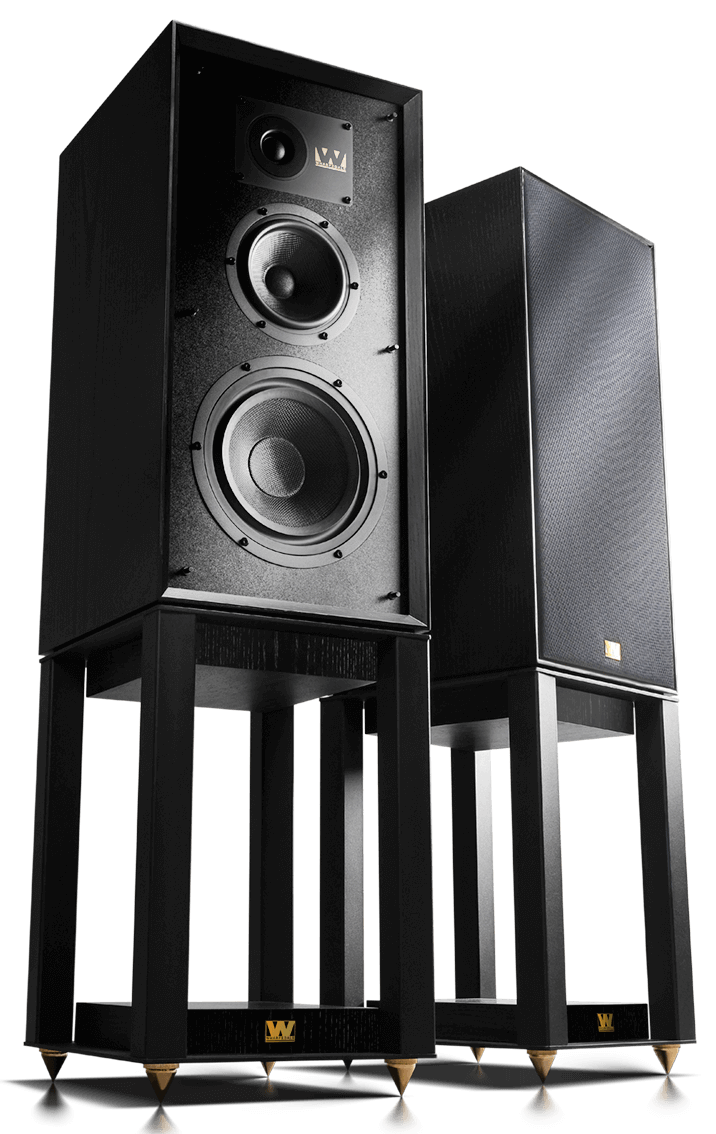
We're polishing this beautiful page just for you...
Just a sec!



The Wharfedale Linton Heritage exploded onto the scene in May 2019 - debuting at the High End show, Munich.
This recreation was an entirely re-engineered classic that dates back to 1965.
It was a classic model of its time, viewed as a serious hi-fi speaker but also relatively affordable. Its cabinet was substantial, big enough to hold three drive units, including a good-sized bass unit, yet not overly unwieldy by the day's standard.
Inspired by the styling of the original Linton, set by Design Consultant Robert Gutmann of the British Design Council, the Linton Heritage makes use of its wide baffle by incorporating a large (by modern standards) bass driver with a 200mm Kevlar cone, mounted on a rigid, die-cast chassis. Above this sits a 135mm midrange driver, also sporting a woven Kevlar cone housed within its own internal enclosure. Finally, a 25mm fabric-dome tweeter with a high-flux ferrite magnet handles high frequencies.

Unconventional for a loudspeaker of today, in many aspects, Linton obeyed the rules of heritage rather than modern convention. Yet, what was lightly frowned upon as ‘old fashioned’, ‘vintage’ or ‘retro’ soon became a trendsetter and disruptor going against market perceptions for ‘modern’, ‘small format’ loudspeakers that were regarded as the ‘norm’ as recently as 2019.
Indeed, a popular anecdote shared by Peter Comeau, the Director of Acoustic Design for Wharfedale – the man behind the Linton Heritage concept; “… some members of the internal sales team didn’t think Linton would be a success. ‘It’s nice, but it’s too large’ or ‘it’s too old fashioned’, were popular quips during development ”. However, mutually championed by Jamie O’Callaghan – Wharfedale’s Global Sales & Marketing Director, the Linton model was nurtured through development and made its debut at the AXPONA show in April 2019, promptly followed by the High-End Show, Munich, in May of that year.
“What became apparent upon public unveiling was a connection with listeners that evoked emotions and memories of classic hi-fi, before measurements and specification became a trend on which loudspeakers are judged before they are even heard…” comments O’Callaghan.
Linton was launched to critical acclaim in May 2019, following the illustrious High-End show, Munich. Such was demand, it was immediately submitted for review and evaluation upon the request of the world’s leading press:

LINTON's
Honours

With this as a launch platform, the Linton Heritage model quickly became a best-seller and sought-after model. Reviews, news, and features spanned the global press and online platforms like wildfire, with new coverage still appearing to this day!
Wharfedale is renowned for its world-class product development team and fast-moving loudspeaker innovations. Even with Linton's success, this team was never going to rest on its laurels.
In the period between Linton’s launch and today, there have been several other notable designs – the DIAMOND 12 and ELYSIAN series, followed by AURA and, more recently, the SUPER DENTON model. Not to mention Wharfedale’s return to UK manufacturing with the DOVEDALE model.






During this period of development, every single piece of feedback has been acknowledged, interpreted, and noted—positive, constructive, and even negative!
Further, a product that can claim as much success as the Wharfedale Linton naturally spurred the incarnation of user communities based around camaraderie and shared affection and appreciation of the model.

“I think it was What Hi-Fi? in which Linton was acknowledged with a glowing five-star review and a ‘reader’s award’”, O’Callaghan mentions. “But they also commented that the LINTON wouldn’t be to ‘everyone’s taste’. No speaker or product is intended for ‘everyone’s’ taste, but it probably can be traced back as one of the sparks for the conversation about what that meant ”.
“One thing we noted, as the communities’ comments evolved, was a desire to see how the generally very impressed owner could be more impressed. A question of ‘how can we get more from Linton’,” says O’Callaghan when asked about some examples of what LINTON fans were pursuing in the hope of improvement. O’Callaghan shared, “the contributions varied from ‘stacking’ multiple speakers to create arrays – which we’ve never done but found fascinating – to changing plinths and stands.”
Part of the growing community conversations around Linton were orientated towards ‘modifications’. Indeed, a Google or YouTube search query of ‘Linton modifications’ returns many posts, pages, videos, and comments discussing and offering ‘solutions’… some of which cost close to the MSRP of the LINTON model itself. Of course, there’s no verifiable evidence that the market is actually absorbing these modifications to any tangible degree, but their very existence adds to the discussion.
Gilbert Briggs, the founder of Wharfedale himself, can be quoted as saying, ‘Measurements can hide a multitude of sins.’ But seemingly, with the growing rate of influencers and more technical reviews using measurements to convey subjective opinions, perhaps a SUPER LINTON concept is able to demonstrate both ends of that spectrum. After all, it’s clear that there’s a following for such an approach.
On the aspect of measurements, Comeau says, “despite, or perhaps because of, its apparent ‘old world’ styling and concept, the Linton Heritage actually measures extremely well.” John Atkinson, in Stereophile’s review, summed it up neatly: “Overall, the Wharfedale Linton Heritage offers excellent measured performance, though that under-damped bass alignment might mean extra care having to be taken in room placement.” Comeau’s view echoes that of Gilbert Briggs: “Clearly, Super Linton has to achieve something more than just fiddling with the measurements.”
An exercise in creating a larger format with more premium loudspeakers has already been demonstrated in the DOVEDALE model.
“DOVEDALE was never intended to be an ‘upgrade’ path for LINTON. DOVEDALE is much more than a UK-built Linton. Put them side by side, and that’s clear to see and probably unfair to both concepts in the most positive of ways. But what struck us was the number of people who assumed it to be exactly that. Linton customers were looking at the upgrade path. Naturally, that raised an internal question about where we take Linton fans; what can we offer them in this very human pursuit of ‘improvement’?”.
As Comeau points out, “a number of users were highlighting the advantages of revising the crossover with more exotic components from boutique manufacturers. However, their followers were clearly uncertain about ‘upsetting the apple cart’ by taking their cherished speakers apart and messing with the internals”.
With Linton being borne out of Wharfedale’s history, a lesson from the past is an easy point of influence. And the resounding success of the Heritage series—a collection that includes Denton 80th, Denton 85th, and, more recently, SUPER DENTON—makes a strong case for history repeating itself!



When asked about what sparked the project's initiation, O’Callaghan explains: “… we posed a sequence of questions IF we were to do a SUPER LINTON: Who are we doing it for? What are they expecting from us? And how can we do this justice?”
Comeau responded, “Although there’s some evidence that upgrading some of the crossover components would bring a margin of improvement, I think what people are looking for is a substantial advance in performance, and this needs to come from an overall review of the project and where we can take the Linton design.”

So ensued a path of development that would take more than three years and thousands of hours, not to mention countless prototypes and an equal amount of changes in format, materials, and techniques.
“Whilst the original SUPER LINTON was little more than an upgraded cabinet design, the new SUPER LINTON Heritage is much, much more than that. To inherit the preposition 'Super', it is clear, from the outset, that this new design has to take every aspect that makes the Linton such a hit amongst listeners and upgrade the performance into something extraordinary.” explains Comeau
“Not only does SUPER LINTON gain a larger, upgraded cabinet, but this extra internal volume has also allowed us to improve the bass unit performance significantly”, comments Comeau. “A more powerful motor system with increased magnet strength now provides not only further extension in the bass, down to 32Hz, but more importantly, adds dramatic bass impact. It improved transient performance from this new bass unit and cabinet plumb depth and detail in the musical performance in a way that is thrilling to experience”.
Taking learnings from the award-winning DOVEDALE model, Comeau shares, “The treble unit uses a lightweight fabric weave dome material is coated with a special damping material and backed by a ceramic magnet-based motor system, very much like the DOVEDALE model. This contributes to a sweet and detailed character. There’s a new, short-horn profile around the dome, too. This supports a smooth response extending down to the upper midrange. Part of this innovation means we could engineer a new front plate. This revised design enhances high-frequency dispersion. As expected, the treble output is precisely formulated to match the transient impact and detailing of the new bass unit.”
Around the technical driver and crossover developments, the SUPER LINTON was afforded further work to enhance the cabinet – a new, specially developed acoustic glue was added to the layers of wood from which the cabinet structure is fabricated. Following the mantra that a loudspeaker is the sum of all its parts, even the internal damping materials were reviewed and evaluated to ensure that the overall performance enhancements were supported mechanically and structurally.
As Comeau says, “The musical performance of a loudspeaker is naturally the sum of its parts, but what many people fail to realise is that it is the skillful blending of the constituents that creates the desired result. Simply ‘upgrading’ one or two components may make some sort of difference, but by viewing the whole upgrade process as a coherent move towards a defined target performance, we can create something which is bigger, better and bolder than the original.”
However, as a brand with more heritage than most and the unparalleled ability to deliver artisan cabinetry, category-leading, and price-point-defying loudspeakers, the Wharfedale LINTON’s appeal has room to expand.

“And with that,” O’Callaghan explains, “SUPER LINTON seemed to create a reason for being all by itself. It became clear that an upgrade path from LINTON was definitely sought – especially based on DOVEDALE’s introduction. But that human desire to improve had an overbearing influence. LINTON is such a great product. Fit, finish and performance. But if we can help it be something more and make it SUPER, then surely a SUPER LINTON is something Wharfedale couldn’t hold back!”

And here it is, ladies and gentlemen:
The Wharfedale
SUPER LINTON!

As Comeau concludes, “When you set up Super Linton Heritage on its dedicated stands, you will find that you are not listening to a loudspeaker but, instead, are drawn into a new musical world, rich in detail and finesse, that allows you to hear exactly how musicians are performing. No matter what the style or genre of the music, Super Linton Heritage makes listening to music in the home a stunningly realistic and emotional experience. This is what high fidelity is meant to be!”
